מיקרוג’וּר מיליג’וּר סנטיג’וּר
Centijour Milijour Microjourהמחוג הכחול מצביע על הסנטיג’וּרים (השעות) The blue hand is pointing to the centijoures (hours)
המחוג הכתום מצביע על המיליג’וּרים (הדקות) The orange hand is pointing to the millijoures (minutes)
המחוג הכחול מצביע על הסנטיג’וּרים (השעות)
The blue hand is pointing to the centijoures (hours)
המחוג הכתום מצביע על המיליג’וּרים (הדקות)
The orange hand is pointing to the millijoures (minutes)


השעון המולטי פלנטרי
The Multi Planetary Clock
The Multi Planetary Clock
Throughout history, the evolution of timekeeping responded to our technological advances, societal needs and the way we reorganized our daily lives.
In ancient times, the measurement of time that was attuned to the movement of the sun, moon and the stars was often imprecise and varied depending on the different regions and seasons. During the summer, the daylight hours were longer, while the winter days were shorter.
As the different societies grew larger and more complex there was a growing need to standardize the measurement of time to facilitate activities such as commerce, transportation and communication.
This advancement led to the invention of various timekeeping devices, such as the water clock and sundial which were frequently lacking in precision.
The water clocks had their limitations because they were affected by changes in water flow, temperature changes and fluidity, while the sundials were reliable on clear sunny days, they could not be used indoors, during the hours of darkness, or on cloudy days.
The invention of the mechanical clock during the middle ages brought about a fundamental change in timekeeping. It offered more precision, standardization and significantly improved timekeeping.
Our planet completes a full rotation on its axis in relation to the fixed stars every 23 hours, 56 minutes, and 4 seconds, known as the sidereal (stars) day.
However, the more commonly used measure is the solar day. During a solar day, our planet completes one full rotation around its axis and moves almost another degree as it orbits the sun (which is, in fact, a star), returning to the same position relative to the sun.
This rotation takes a bit longer to complete, averaging approximately 24 hours.
The widespread consensus to divide the day into 12 hours of day and 12 hours of night, played a significant role in shaping our contemporary timekeeping system.
Over the past centuries, technological progress led to significant improvements in the accuracy, reliability and accessibility of the mechanical clocks.
From spring driven and pendulum clocks the advancement to pocket and wristwatches with miniaturised mechanisms, made timekeeping more personalised and convenient.
We are currently living at the dawn of the interplanetary space travel era.
Although the most sophisticated space crafts have not yet travelled beyond our solar system.
Based on the course of history, as our understanding of space exploration advances, the likelihood of discovering new technologies that will lead to interplanetary travel as part of our daily routine is quite probable.
Consequently, at some point the transition from a geocentric to a universal perspective will become inevitable.
There are countless galaxies in the universe, each containing an infinite number of solar systems with planets similar to our own. Given the diversity observed within our solar system, it is reasonable to assume that other planets are likely rotate around their own axes at different times.
When interplanetary travel will begin, the existing 24 hour division of time, comprising of 60 minutes in an hour and 60 seconds in a minute will become too complex.
In order to accommodate the new day and night cycles of other planets, a standardized measurement of time based on the division of the day into 100 units, as in percentages, would simplify time calculations for travellers.
The subdivision of time into 100 units will help organize time efficiently and plan daily activities with maximum precision.
The transition to a 100 unit clock division would require a significant cultural shift. Widespread updates and changes to the existing timekeeping methods, in computerized systems, software and devices based on the measurement of time.
However, once this new time system will become globally standardized, it will simplify the communication and cooperation between the different groups living on different planets and time zones.

When facing South from the Northern Hemisphere and the Southern Hemisphere, sunrise will always be on the left in the East and the sunset on the right in the West.
In every time zone on any planet, the multi planetary clock starts at the beginning of a new daylight at centijuor 0 (6:00 AM) and ends at centijour 100.
1 Centijour = 14:24 minutes and seconds
1 Millijour = 8:64 seconds
1 Microjur = 0.0864 parts of a second
1 Nanojour = 0.000864 parts of a second
The multi planetary clock compared with our current local clock.
1 day = 100 centijours,
1 centijour = 100 millijours,
1 millijour = 100 microjours,
1 microjours = 100 nanojour, and so on…
The division of the multi planetary clock.
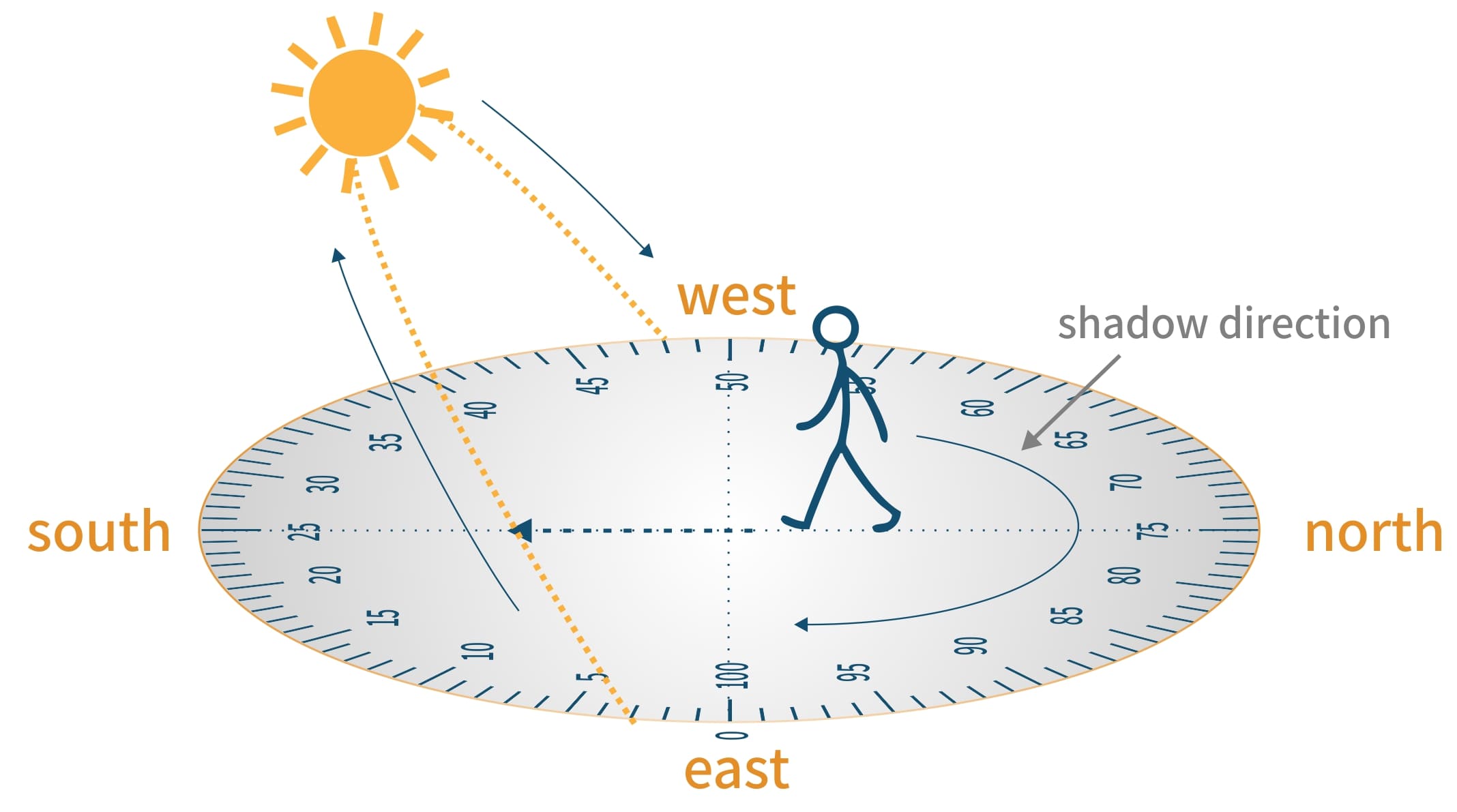
Northern Hemisphere - summer
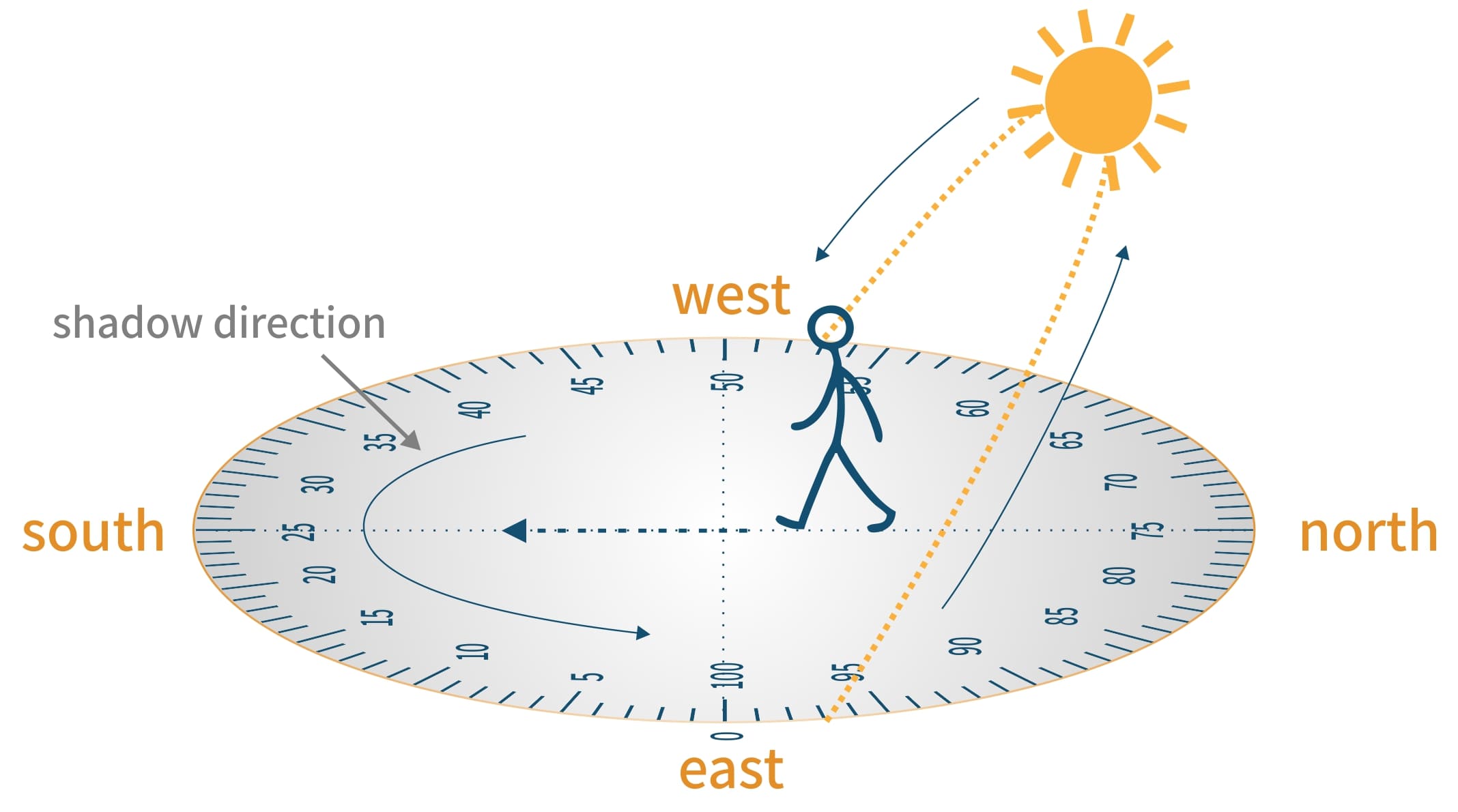
Southern Hemisphere - summer
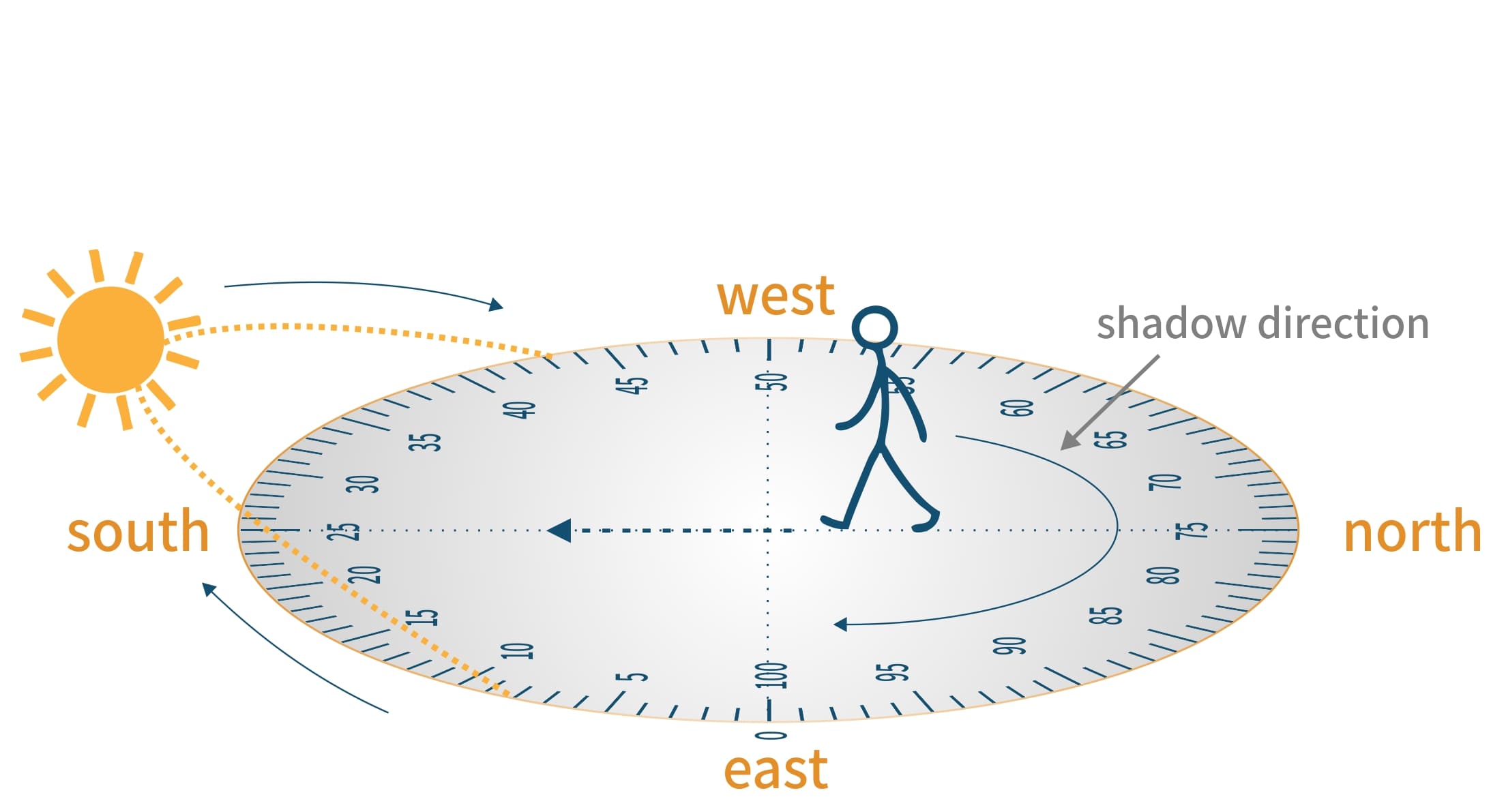
Northern Hemisphere - winter

Northern Hemisphere - winter
In the Northern Hemisphere, the shadow cast by the sun moves in a clockwise direction, and in the Southern Hemisphere the shadow moves counter clockwise.
Except for the polar regions, everywhere else on our garden planet the sun rises in the east and sets in the west.
The only thing that does change between the northern and southern hemispheres is the angle of the sun’s path and the shadow it casts.
In the Northern Hemisphere, the shadow cast by the sun moves in a clockwise direction, and in the Southern Hemisphere the shadow moves counterclockwise.
Only during the equinoxes on the equator, the sun rises due East at 0 centijour (6:00 AM), passes directly overhead at centijour 25 (12:00 PM) noon, and sets due West at centijour 50 (6:00 PM).
In all other latitudes as we move away from the equator towards the north or south poles, the position of the sun lowers, shifting towards the south or north east during sunrise and south or north west during sunset.
The tradition of clockwise motion, from left to right, can be traced back to the invention of sundials and the development of the mechanical clocks in the Northern Hemisphere.
Over the centuries, people around the planet adopted this tradition as a standardized way to measure time globally.
Therefore symbolically instead of the traditional 0 point at midnight, the 0 point of the multi planetary clock is located on the left side of the clock, aligned with the sun rising due east on the equator during the equinoxes.
השעון המולטי פלנטרי
לאורך ההיסטוריה, מדידת הזמן התפתחה כתוצאה מהתקדמות טכנולוגית, הצרכים החברתיים והאופן שבו ארגנו את חיי היומיום שלנו.
בימי קדם, מדידת הזמן שהייתה מותאמת לתנועת השמש, הירח והכוכבים הייתה לרוב עם אי דיוקים, והשתנתה בהתאם לאזורים ולעונות השנה השונים. בקיץ שעות האור היו ארוכות יותר ואילו ימי החורף היו קצרים יותר.
ככל שהחברות השונות התפתחו ונעשו מורכבות יותר, גדל הצורך בסטנדרטיזציה של מדידת הזמן כדי להקל על פעילויות כמו מסחר, תחבורה ותקשורת.
התפתחות זו הובילה להמצאת התקני שמירת זמן שונים, כמו שעון המים ושעון השמש, שלעתים קרובות חסרו דיוק.
לשעוני המים היו מגבלות כיוון שהם הושפעו משינויים בזרימת המים, שינויי טמפרטורה ונזילות, ואילו שעוני השמש, על אף שהיו אמינים בימי שמש בהירים, לא ניתן היה להשתמש בהם בתוך מבנים, בשעות החשיכה או בימים מעוננים.
המצאת השעון המכני בתקופת ימי הביניים חוללה שינוי מהותי בשמירת הזמן. שעונים אלו הציעו דיוק רב יותר, סטנדרטיזציה ושפרו באופן משמעותי את קביעת הזמן.
הפלנטה שלנו משלימה סיבוב מלא על צירה ביחס לכוכבים הקבועים כל 23 שעות, 56 דקות ו-4 שניות, המכונה יממה כוכבית (יממה סַיְדֶרִיאַלית).
עם זאת, המדידה הנפוצה יותר היא היממה השמשית. במהלך היממה השמשית, הפלנטה שלנו משלימה סיבוב שלם אחד על צירה ונעה כמעט מעלה נוספת כשהיא מקיפה את השמש (שהיא למעשה כוכב), וחוזרת לאותו מיקום ביחס לשמש. סיבוב זה לוקח קצת יותר זמן להשלים, בממוצע של כ 24 שעות.
הקונצנזוס הנרחב לחלק את היום ל 12 שעות של יום ו 12 שעות של לילה, היה משמעותי בעיצוב מערכת שמירת הזמן העכשווי שלנו.
במהלך מאות השנים האחרונות, ההתקדמות הטכנולוגית הובילה לשיפורים משמעותיים ברמת הדיוק, באמינות והנגישות של השעונים המכניים.
משעוני הקפיצים והמטוטלת, ההתפתחות לשעוני כיס ושעוני יד עם מנגנונים ממוזערים שינתה את שמירת הזמן, למותאמת אישית ונוחה יותר.
נכון לעכשיו אנחנו חיים בשחר עידן המסעות הבין פלנטריים ביקום.
למרות שהחלליות המתוחכמות ביותר עדיין לא עזבו את מערכת השמש שלנו.
בהתבסס על מהלכי ההיסטוריה, קרוב לוודאי, ככל שההבנה שלנו בחקר היקום תתקדם, הסבירות לגילוי טכנולוגיות חדשות, שיביאו למסעות בין פלנטריים שיהוו כחלק משגרת חיינו היומיומיים, היא סבירה למדי.
כתוצאה מכך, בשלב מסוים המעבר מהפרספקטיבה הגיאוצנטרית לאוניברסלית יהיה בלתי נמנע.
ישנם אינספור גלקסיות ביקום, כל אחת מהן מכילה מספר אינסופי של מערכות שמש עם פלנטות הדומות לשלנו. בהתחשב שבמערכת השמש שלנו יש פלנטות שונות, סביר להניח שבמערכות שמש אחרות הפלנטות עשויות להסתובב סביב צירן בזמנים שונים.
כאשר המסע הבין פלנטרי יתחיל, חלוקת הזמן הנוכחית של 24 שעות הכוללת 60 דקות בשעה ו 60 שניות בדקה, תהיה מורכבת מדי.
על מנת להתאים את מחזורי היום והלילה החדשים של פלנטות אחרות, מדידה סטנדרטית של זמן המבוססת על חלוקת היום ל 100 יחידות, כמו באחוזים, תפשט את חישובי הזמן עבור מטיילים.
חלוקת הזמן ל 100 יחידות תעזור לארגן את הזמן ביעילות ולתכנן את הפעילויות היומיומיות בדיוק מרבי.
המעבר לחלוקת השעון ל 100 יחידות ידרוש שינוי תרבותי משמעותי. יידרשו עדכונים ושינויים נרחבים בשיטות מדידת הזמן הקיימות, במערכות הממוחשבות, תוכנות ובמכשירים המבוססים על מדידת זמן.
עם זאת, ברגע שמדידת זמן חדשה זו תהיה סטנדרטית באופן גלובלי, היא תפשט את התקשורת ושיתוף הפעולה בין הקבוצות השונות שמתגוררות בפלנטות ואזורי זמן שונים.
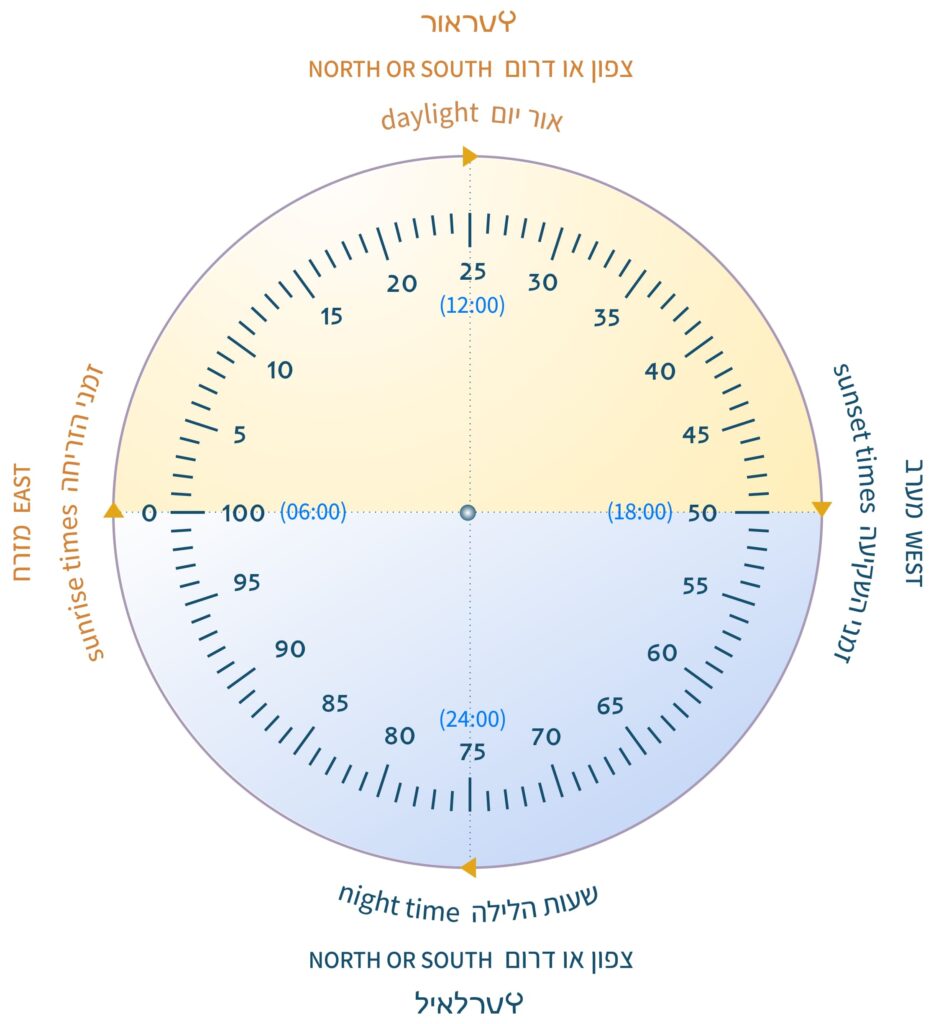
במבט לכיוון דרום, כאשר עומדים בכל מקום בפלנטת הגן שלנו, זריחת המאור תמיד תהיה בצד שמאל במזרח, והשקיעה תמיד בצד ימין במערב.
בכל אזורי הזמן בכל פלנטה, השעון מתחיל בתחילתו של ג’וראור (אור יום) חדש, בסנטיג’ור 0 (6:00), ומסתיים בסיום הג’ורליל (לילה) בסנטיג’ור 100.
סנטיג’ור 1 = 14:24 דקות ושניות
מיליג’ור 1 = 8:64 שניות
מיקרוג’ור 1 = 0.864 חלקי השנייה
ננוג’ור 1 = 0.0864 חלקי השנייה
השעון המולטי פלנטרי בהשוואה לשעון המקומי הנוכחי שלנו.
ג’ור 1 = 100 סנטיג’ורים,
סנטיג’ור1 = 100 מיליג’ורים,
מיליג’ור 1 = 100 מיקרוג’ורים,
מיקרוג’ור 1 = 100 ננוג’ורים, וכן הלאה…
החלוקה של השעון המולטי פלנטרי.
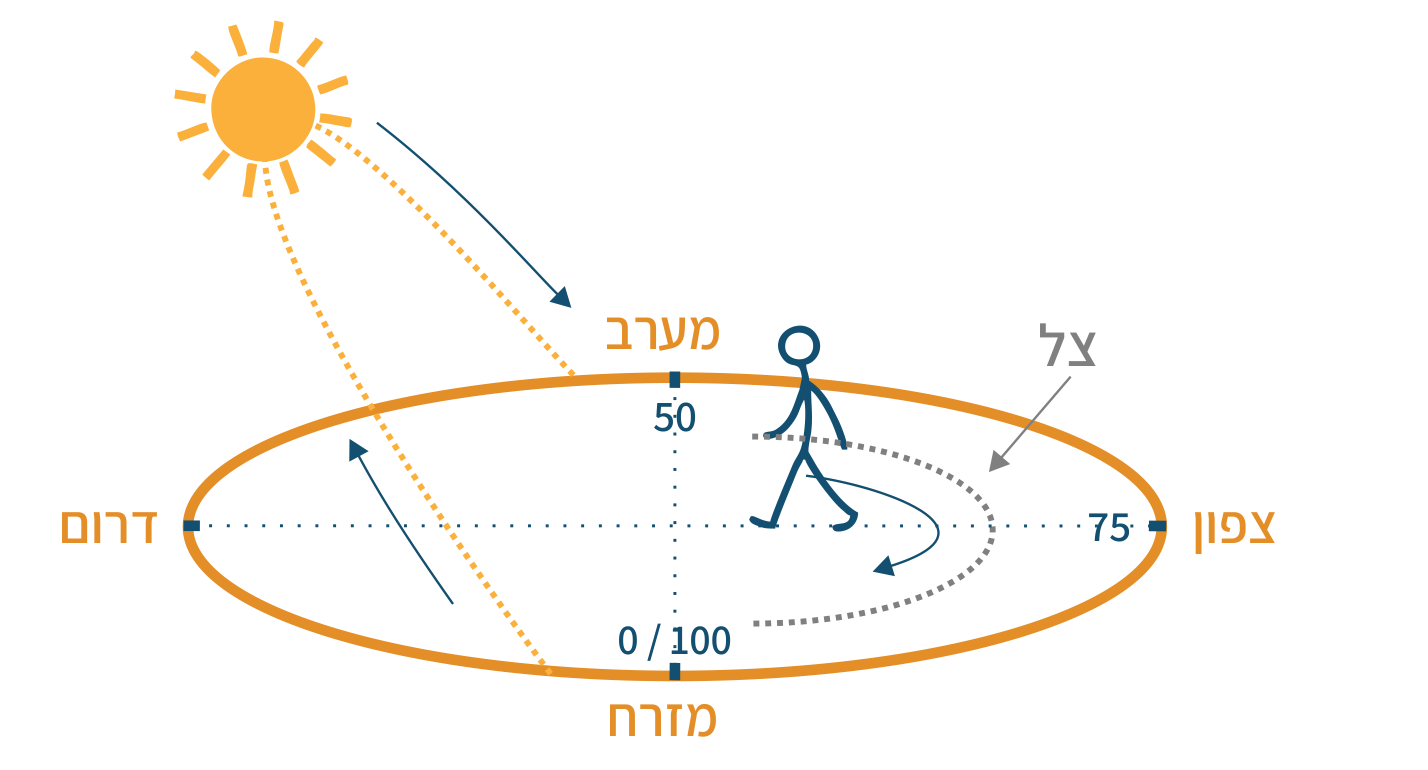
ההמיספרה הצפונית בקיץ

ההמיספרה הדרומית בקיץ
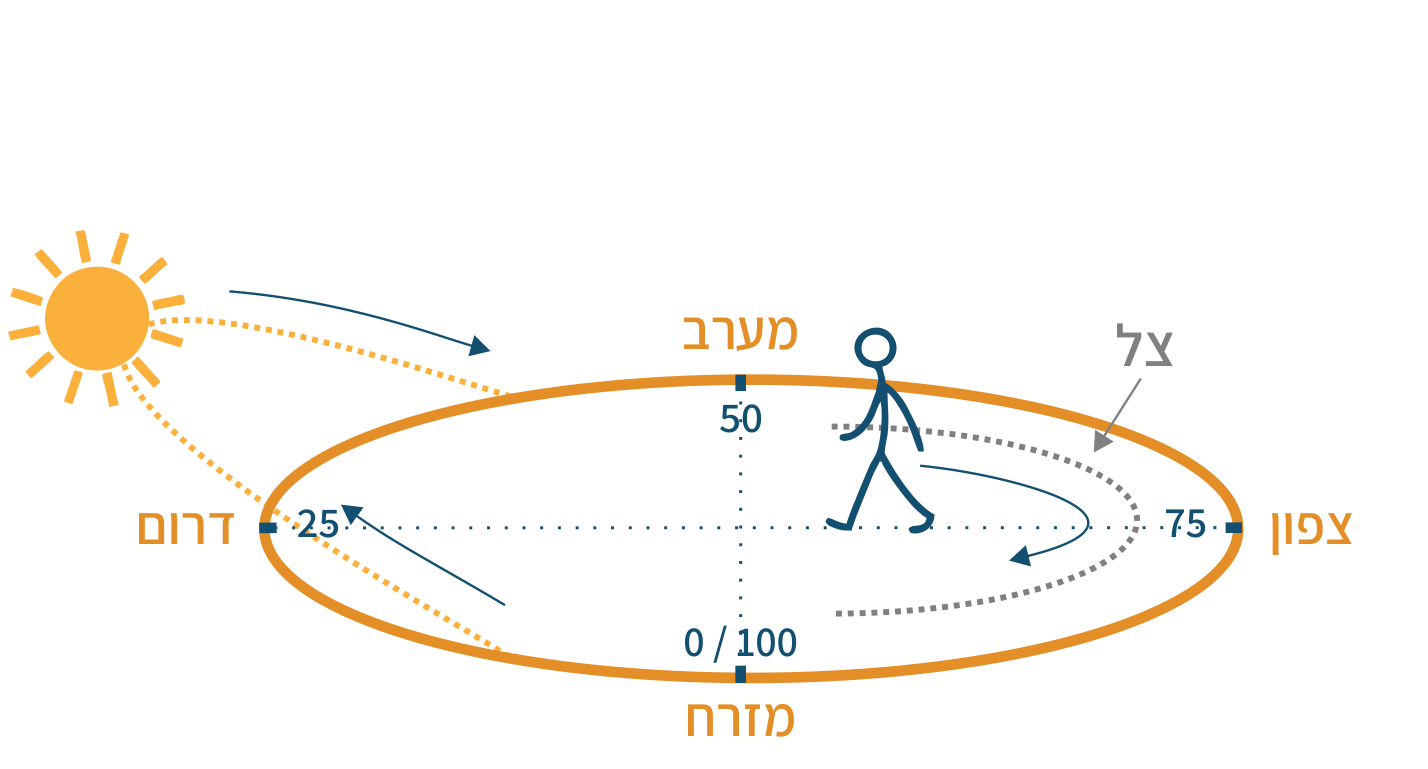
ההמיספרה הצפונית בחורף
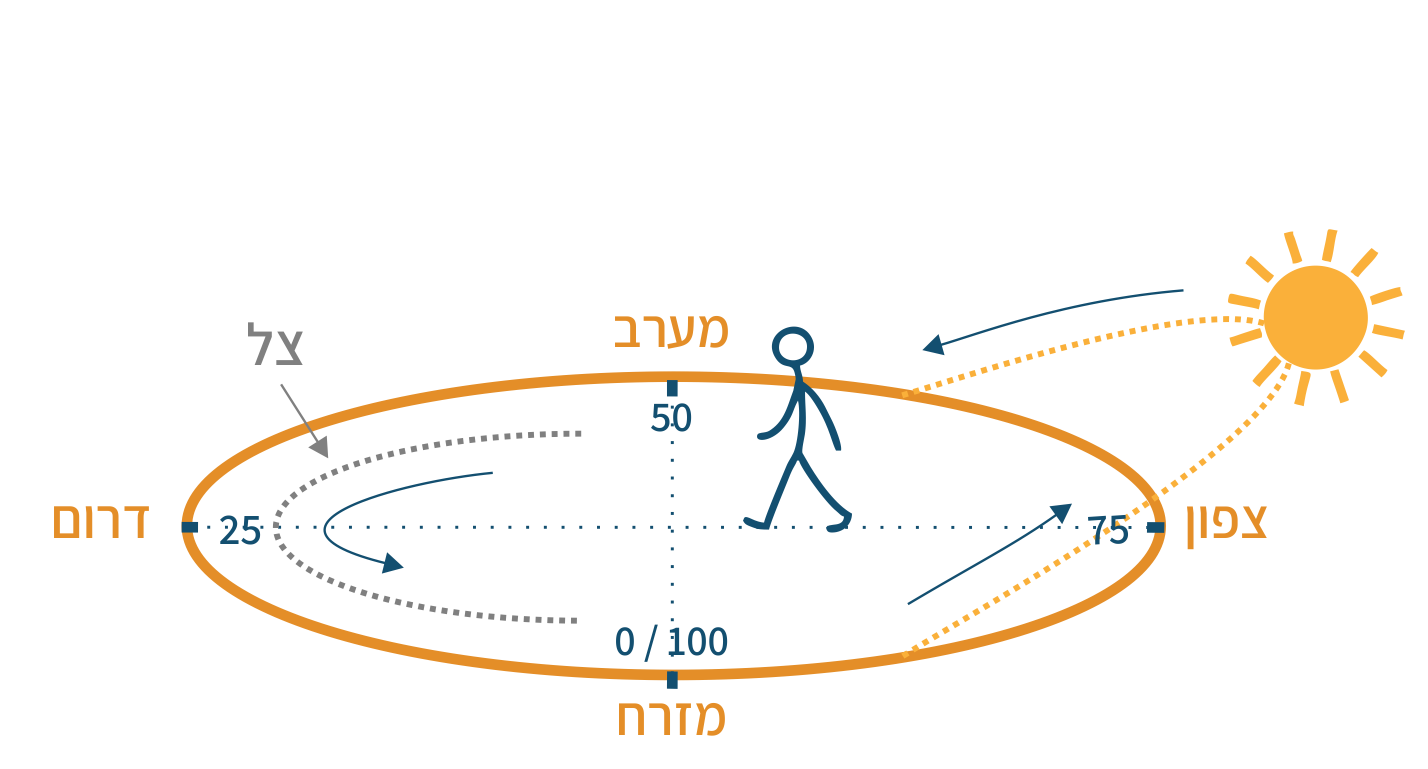
ההמיספרה הדרומית בחורף
מלבד אזור הקטבים, בכל מקום בפלנטת הגן שלנו השמש זורחת במזרח ושוקעת במערב.
הדבר היחיד שכן משתנה בין ההמיספרה הצפונית והדרומית, היא זווית מסלול השמש בין הזריחה והשקיעה, והצל שהשמש מטילה. בהמיספרה הצפונית הצל שהשמש מטילה נע בכיוון השעון, ובהמיספרה הדרומית הצל נע נגד כיוון השעון.
רק על קו המשווה במהלך ימי השוויון השמש זורחת בדיוק במזרח בסנטיג’ור 0 (6:00 בבוקר), נעה ישירות מעל הראש ב 25 סנטיג’ורים (12:00 בצהריים), ושוקעת בדיוק במערב בסנטייג’ור 50 סנטייור (6:00 בערב).
בכל שאר קווי הרוחב כאשר אנחנו מתרחקים מקו המשווה לכיוון הקוטב הצפוני או הדרומי, מיקום השמש יורד, נע לכיוון דרום או צפון מזרח בזמן הזריחה, ודרום או צפון מערב בזמן השקיעה.
את מסורת תנועת כיוון השעון משמאל לימין, ניתן ליחס להמצאת שעוני השמש, ופיתוח השעונים המכניים בהמיספרה הצפונית.
במשך מאות שנים, אנשים ברחבי הפלנטה אימצו מסורת זו כדרך סטנדרטית למדידת זמן גלובלי.
לכן באופן סמלי במקום נקודת ה 0 המסורתית בחצות, נקודת ה 0 של השעון המולטי פלנטרי ממוקמת בצד שמאל של השעון, לפי מיקום זריחת השמש במזרח על קו המשווה במהלך ימי השוויון.
The Multi Planetary Clock
Throughout history, the evolution of timekeeping responded to our technological advances, societal needs and the way we reorganized our daily lives.
In ancient times, the measurement of time that was attuned to the movement of the sun, moon and the stars was often imprecise and varied depending on the different regions and seasons. During the summer, the daylight hours were longer, while the winter days were shorter.
As the different societies grew larger and more complex there was a growing need to standardize the measurement of time to facilitate activities such as commerce, transportation and communication.
This advancement led to the invention of various timekeeping devices, such as the water clock and sundial which were frequently lacking in precision.
The water clocks had their limitations because they were affected by changes in water flow, temperature changes and fluidity, while the sundials were reliable on clear sunny days, they could not be used indoors, during the hours of darkness, or on cloudy days.
The invention of the mechanical clock during the middle ages brought about a fundamental change in timekeeping. It offered more precision, standardization and significantly improved timekeeping.
Our planet completes a full rotation on its axis in relation to the fixed stars every 23 hours, 56 minutes, and 4 seconds, known as the sidereal (stars) day.
However, the more commonly used measure is the solar day. During a solar day, our planet completes one full rotation around its axis and moves almost another degree as it orbits the sun (which is, in fact, a star), returning to the same position relative to the sun.
This rotation takes a bit longer to complete, averaging approximately 24 hours.
The widespread consensus to divide the day into 12 hours of day and 12 hours of night, played a significant role in shaping our contemporary timekeeping system.
Over the past centuries, technological progress led to significant improvements in the accuracy, reliability and accessibility of the mechanical clocks.
From spring driven and pendulum clocks the advancement to pocket and wristwatches with miniaturised mechanisms, made timekeeping more personalised and convenient.
We are currently living at the dawn of the interplanetary space travel era.
Although the most sophisticated space crafts have not yet travelled beyond our solar system.
Based on the course of history, as our understanding of space exploration advances, the likelihood of discovering new technologies that will lead to interplanetary travel as part of our daily routine is quite probable.
Consequently, at some point the transition from a geocentric to a universal perspective will become inevitable.
There are countless galaxies in the universe, each containing an infinite number of solar systems with planets similar to our own. Given the diversity observed within our solar system, it is reasonable to assume that other planets are likely rotate around their own axes at different times.
When interplanetary travel will begin, the existing 24 hour division of time, comprising of 60 minutes in an hour and 60 seconds in a minute will become too complex.
In order to accommodate the new day and night cycles of other planets, a standardized measurement of time based on the division of the day into 100 units, as in percentages, would simplify time calculations for travellers.
The subdivision of time into 100 units will help organize time efficiently and plan daily activities with maximum precision.
The transition to a 100 unit clock division would require a significant cultural shift. Widespread updates and changes to the existing timekeeping methods, in computerized systems, software and devices based on the measurement of time.
However, once this new time system will become globally standardized, it will simplify the communication and cooperation between the different groups living on different planets and time zones.

When facing South from the Northern Hemisphere and the Southern Hemisphere, sunrise will always be on the left in the East and the sunset on the right in the West.
In every time zone on any planet, the multi planetary clock starts at the beginning of a new daylight at centijuor 0 (6:00 AM) and ends at centijour 100.
Centijour 1 = 14:24 minutes and seconds
Millijour 1 = 8:64 seconds
Microjur 1 = 0.0864 parts of a second
Nanojour 1 = 0.000864 parts of a second
The multi planetary clock compared with our current local clock.
1 day = 100 centijours,
1 centijour = 100 millijours,
1 millijour = 100 microjours,
1 microjours = 100 nanojour, and so on…
The division of the multi planetary clock.

Northern Hemisphere - summer

Southern Hemisphere - summer

Northern Hemisphere - winter

Northern Hemisphere - winter
In the Northern Hemisphere, the shadow cast by the sun moves in a clockwise direction, and in the Southern Hemisphere the shadow moves counter clockwise.
Except for the polar regions, everywhere else on our garden planet the sun rises in the east and sets in the west.
The only thing that does change between the northern and southern hemispheres is the angle of the sun’s path and the shadow it casts.
In the Northern Hemisphere, the shadow cast by the sun moves in a clockwise direction, and in the Southern Hemisphere the shadow moves counterclockwise.
Only during the equinoxes on the equator, the sun rises due East at 0 centijour (6:00 AM), passes directly overhead at centijour 25 (12:00 PM) noon, and sets due West at centijour 50 (6:00 PM).
In all other latitudes as we move away from the equator towards the north or south poles, the position of the sun lowers, shifting towards the south or north east during sunrise and south or north west during sunset.
The tradition of clockwise motion, from left to right, can be traced back to the invention of sundials and the development of the mechanical clocks in the Northern Hemisphere.
Over the centuries, people around the planet adopted this tradition as a standardized way to measure time globally.
Therefore symbolically instead of the traditional 0 point at midnight, the 0 point of the multi planetary clock is located on the left side of the clock, aligned with the sun rising due east on the equator during the equinoxes.
השעון המולטי פלנטרי
לאורך ההיסטוריה, מדידת הזמן התפתחה כתוצאה מהתקדמות טכנולוגית, הצרכים החברתיים והאופן שבו ארגנו את חיי היומיום שלנו.
בימי קדם, מדידת הזמן שהייתה מותאמת לתנועת השמש, הירח והכוכבים הייתה לרוב עם אי דיוקים, והשתנתה בהתאם לאזורים ולעונות השנה השונים. בקיץ שעות האור היו ארוכות יותר ואילו ימי החורף היו קצרים יותר.
ככל שהחברות השונות התפתחו ונעשו מורכבות יותר, גדל הצורך בסטנדרטיזציה של מדידת הזמן כדי להקל על פעילויות כמו מסחר, תחבורה ותקשורת.
התפתחות זו הובילה להמצאת התקני שמירת זמן שונים, כמו שעון המים ושעון השמש, שלעתים קרובות חסרו דיוק.
לשעוני המים היו מגבלות כיוון שהם הושפעו משינויים בזרימת המים, שינויי טמפרטורה ונזילות, ואילו שעוני השמש, על אף שהיו אמינים בימי שמש בהירים, לא ניתן היה להשתמש בהם בתוך מבנים, בשעות החשיכה או בימים מעוננים.
המצאת השעון המכני בתקופת ימי הביניים חוללה שינוי מהותי בשמירת הזמן. שעונים אלו הציעו דיוק רב יותר, סטנדרטיזציה ושפרו באופן משמעותי את קביעת הזמן.
הפלנטה שלנו משלימה סיבוב מלא על צירה ביחס לכוכבים הקבועים כל 23 שעות, 56 דקות ו-4 שניות, המכונה יממה כוכבית (יממה סַיְדֶרִיאַלית).
עם זאת, המדידה הנפוצה יותר היא היממה השמשית. במהלך היממה השמשית, הפלנטה שלנו משלימה סיבוב שלם אחד על צירה ונעה כמעט מעלה נוספת כשהיא מקיפה את השמש (שהיא למעשה כוכב), וחוזרת לאותו מיקום ביחס לשמש. סיבוב זה לוקח קצת יותר זמן להשלים, בממוצע של כ 24 שעות.
הקונצנזוס הנרחב לחלק את היום ל 12 שעות של יום ו 12 שעות של לילה, היה משמעותי בעיצוב מערכת שמירת הזמן העכשווי שלנו.
במהלך מאות השנים האחרונות, ההתקדמות הטכנולוגית הובילה לשיפורים משמעותיים ברמת הדיוק, באמינות והנגישות של השעונים המכניים.
משעוני הקפיצים והמטוטלת, ההתפתחות לשעוני כיס ושעוני יד עם מנגנונים ממוזערים שינתה את שמירת הזמן, למותאמת אישית ונוחה יותר.
נכון לעכשיו אנחנו חיים בשחר עידן המסעות הבין פלנטריים ביקום.
למרות שהחלליות המתוחכמות ביותר עדיין לא עזבו את מערכת השמש שלנו.
בהתבסס על מהלכי ההיסטוריה, קרוב לוודאי, ככל שההבנה שלנו בחקר היקום תתקדם, הסבירות לגילוי טכנולוגיות חדשות, שיביאו למסעות בין פלנטריים שיהוו כחלק משגרת חיינו היומיומיים, היא סבירה למדי.
כתוצאה מכך, בשלב מסוים המעבר מהפרספקטיבה הגיאוצנטרית לאוניברסלית יהיה בלתי נמנע.
ישנם אינספור גלקסיות ביקום, כל אחת מהן מכילה מספר אינסופי של מערכות שמש עם פלנטות הדומות לשלנו. בהתחשב שבמערכת השמש שלנו יש פלנטות שונות, סביר להניח שבמערכות שמש אחרות הפלנטות עשויות להסתובב סביב צירן בזמנים שונים.
כאשר המסע הבין פלנטרי יתחיל, חלוקת הזמן הנוכחית של 24 שעות הכוללת 60 דקות בשעה ו 60 שניות בדקה, תהיה מורכבת מדי.
על מנת להתאים את מחזורי היום והלילה החדשים של פלנטות אחרות, מדידה סטנדרטית של זמן המבוססת על חלוקת היום ל 100 יחידות, כמו באחוזים, תפשט את חישובי הזמן עבור מטיילים.
חלוקת הזמן ל 100 יחידות תעזור לארגן את הזמן ביעילות ולתכנן את הפעילויות היומיומיות בדיוק מרבי.
המעבר לחלוקת השעון ל 100 יחידות ידרוש שינוי תרבותי משמעותי. יידרשו עדכונים ושינויים נרחבים בשיטות מדידת הזמן הקיימות, במערכות הממוחשבות, תוכנות ובמכשירים המבוססים על מדידת זמן.
עם זאת, ברגע שמדידת זמן חדשה זו תהיה סטנדרטית באופן גלובלי, היא תפשט את התקשורת ושיתוף הפעולה בין הקבוצות השונות שמתגוררות בפלנטות ואזורי זמן שונים.

במבט לכיוון דרום, כאשר עומדים בכל מקום בפלנטת הגן שלנו, זריחת המאור תמיד תהיה בצד שמאל במזרח, והשקיעה תמיד בצד ימין במערב.
בכל אזורי הזמן בכל פלנטה, השעון מתחיל בתחילתו של ג’וראור (אור יום) חדש, בסנטיג’ור 0 (6:00), ומסתיים בסיום הג’ורליל (לילה) בסנטיג’ור 100.
סנטיג’ור 1 = 14:24 דקות ושניות
מיליג’ור 1 = 8:64 שניות
מיקרוג’ור 1 = 0.0864 חלקי השנייה
ננוג’ור 1 = 0.000864 חלקי השנייה
השעון המולטי פלנטרי בהשוואה לשעון המקומי הנוכחי שלנו.
ג’ור 1 = 100 סנטיג’ורים,
סנטיג’ור1 = 100 מיליג’ורים,
מיליג’ור 1 = 100 מיקרוג’ורים,
מיקרוג’ור 1 = 100 ננוג’ורים,
וכן הלאה…
החלוקה של השעון המולטי פלנטרי.

ההמיספרה הצפונית בקיץ

ההמיספרה הדרומית בקיץ

ההמיספרה הצפונית בחורף

ההמיספרה הדרומית בחורף
מלבד אזור הקטבים, בכל מקום בפלנטת הגן שלנו השמש זורחת במזרח ושוקעת במערב.
הדבר היחיד שכן משתנה בין ההמיספרה הצפונית והדרומית, היא זווית מסלול השמש בין הזריחה והשקיעה, והצל שהשמש מטילה. בהמיספרה הצפונית הצל שהשמש מטילה נע בכיוון השעון, ובהמיספרה הדרומית הצל נע נגד כיוון השעון.
רק על קו המשווה במהלך ימי השוויון השמש זורחת בדיוק במזרח בסנטיג’ור 0 (6:00 בבוקר), נעה ישירות מעל הראש ב 25 סנטיג’ורים (12:00 בצהריים), ושוקעת בדיוק במערב בסנטייג’ור 50 סנטייור (6:00 בערב).
בכל שאר קווי הרוחב כאשר אנחנו מתרחקים מקו המשווה לכיוון הקוטב הצפוני או הדרומי, מיקום השמש יורד, נע לכיוון דרום או צפון מזרח בזמן הזריחה, ודרום או צפון מערב בזמן השקיעה.
את מסורת תנועת כיוון השעון משמאל לימין, ניתן ליחס להמצאת שעוני השמש, ופיתוח השעונים המכניים בהמיספרה הצפונית.
במשך מאות שנים, אנשים ברחבי הפלנטה אימצו מסורת זו כדרך סטנדרטית למדידת זמן גלובלי.
לכן באופן סמלי במקום נקודת ה 0 המסורתית בחצות, נקודת ה 0 של השעון המולטי פלנטרי ממוקמת בצד שמאל של השעון, לפי מיקום זריחת השמש במזרח על קו המשווה במהלך ימי השוויון.